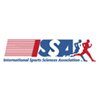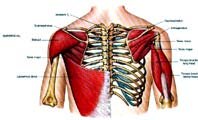Is the lat pull-down the best and safest latissimus dorsi exercise? Why are most people stronger in a lat pull or pull-up when they use a palms-up grip? Is the latissimus dorsi involved in a row type exercise? Does changing my arm position during a rowing exercise effect which back muscles are incorporated? A basic understanding of the anatomy and kinesiology of the latissimus dorsi and surrounding structures makes these questions much less intimidating.
Anatomy
The lattisimus dorsi is a large muscle with a very broad origin on the vertebrae and ribs of the mid to low back, tapering into a narrow insertion on the anterior (front) of the head of the humerus bone of the arm. From the surface, this muscle runs in a mostly vertical fashion up the sides of the back giving the upper body its "V" shape. All of the muscle fibers in the latissimus dorsi are virtually parallel, making the entire muscle function with the same action on the arm. This is a different situation from the two heads of the pectoralis major with distinctly different fiber angles and actions on the arm (2,3,4). You cannot train "parts" of the latissimus dorsi.
Any discussion of the latissimus dorsi must include a mention of the teres major muscle. The teres major is commonly referred to as the "lats little helper" because the two have the exact same action on the arm. It is impossible to train one without the other. The origin of the teres major is on the lower edge of the scapulae (shoulder blades) above the latissimus dorsi. The insertion is on the head of the humerus, in virtually the same spot as the insertion of the latissimus dorsi (2,3). For the remainder of this article, the teres major will be considered to be an extension of the latissimus dorsi and will not be mentioned separately.
Kinesiology
The latissimus dorsi has two main actions on the arm. It functions in adduction (pulling the arms to the sides of the body from an out-to-the-side position) and extension (pulling the arms down from a horizontal position straight out in front of the body (2,3,4). As we will see, knowing these two primary actions will be a great tool for handling lat exercise dilemmas.
Exercise and Development
 The lat pull-down is indeed a great exercise for the latissimus dorsi. When performed with a variety of arm positions, there is probably no other exercise that targets the lats so effectively. When you are using a wide grip, the motion is pure arm adduction. A narrow grip (hands shoulder width) incorporates arm extension. A grip in between is a combination of both extension and adduction. Remember that extension and adduction are the two main actions of the latissimus dorsi. To most effectively train the lats, it is best to incorporate a variety of grip widths into your training to work the latissimus dorsi in both of its prime actions.
The lat pull-down is indeed a great exercise for the latissimus dorsi. When performed with a variety of arm positions, there is probably no other exercise that targets the lats so effectively. When you are using a wide grip, the motion is pure arm adduction. A narrow grip (hands shoulder width) incorporates arm extension. A grip in between is a combination of both extension and adduction. Remember that extension and adduction are the two main actions of the latissimus dorsi. To most effectively train the lats, it is best to incorporate a variety of grip widths into your training to work the latissimus dorsi in both of its prime actions.
Recognize that the pull-up is mechanically the same exercise as the lat pull, thus the same principles apply. There is one drawback to the lat-pull. Repeated arms-over-the-head types of activities have been linked to a condition called shoulder impingement syndrome. For this reason, it is advisable to use other exercises such as the row (discussed later in this article) to train the lats if a physician has ever told you that you have or are prone to this condition. (1)
So, why are most people stronger in a lat pull or pull-up when they use a palms-up grip? The answer has to do with the biceps of the arm. Elbow flexion is a part of the movement of a lat pull. The biceps are a primary muscle responsible for elbow flexion. The biceps have a mechanical advantage in elbow flexion when the palms are up (supination) as opposed to down (pronation). This is partly because of the different positions of the radius bone the biceps insert on with pronation and supination of the hand. The biceps contribute more force to the movement when the palms are up, causing the weight lifter to produce more force in the exercise when done in this fashion.
Rows
Last but certainly not least, the row dilemma. A rowing exercise would be a seated cable row, T-bar row, bent over dumbell or barbell row or any machine simulating the same type of movement. Does a rowing exercise work the lats?
It all depends on the position of the arms during the movement. Keeping the elbows close to the side of the body during the movement creates arm extension. If you remember that extension is a prime action of the latissimus dorsi, you will understand that indeed doing the exercise in this fashion does work the lats very well.
Doing the exercise with the elbows high, or arms perpendicular to the body, reduces the leverage of the lats. This type of motion is called horizontal arm abduction. This is not a prime action of the lats. It is very much a prime action of the rear deltoids, teres minor and infraspinatus (see illustration) (2). Doing a rowing exercise in this fashion trains the rear deltoids, teres minor and infraspinatus very well. It is not a very effective way to train the lats.
Understanding the information in this article is a powerful tool to be used to get the most effective results from weight training for the back. As a trainer, if you have not already had to face these issues, it is merely a matter of time before you do. Now you are armed with the facts to provide professional solutions. Feel free to contact me with any questions or comments at parsons@issaonline.com. Good luck with your training!
| Lat Pulldown Straight Arm Pulldown Bent Over Rows Other |
|
References
Arnheim, D.D., Prentice, W.E., Principles of athletic training. 9th ed. McGraw Hill, pp 571-572, 1997.
Francis, P., Applied anatomy and kinesiology, supplemental materials. KB Books., p 19,1999.
Rasch, P.J., Kinesiology and applied anatomy. 7th ed. Lea and Febiger, p 123, 1989.
Timmons, M.J., Martini, F.H., Human anatomy, 2nd ed. Prentice Hall, p 282, 1997.
Thanks,
Dustin Parsons B.S.

